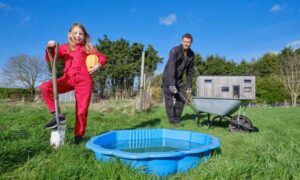
It is November. It is 3am and I am lying awake listening to the sound of rats chewing the electrical wires within the walls of my house. If you’ve ever heard mice or rats scuttling around in the walls, you’ll know how annoying it can be. Imagine that, but with the rats separated from your head by only a slice of MDF. The scratching and gnawing is so loud, I can’t get back to sleep.
Last night I spent the evening convincing my children that the noise is just a family of squirrels who have made a nest on our roof. We try to be kind to all creatures, here on our off-grid farm. There is something about rats, however, that triggers my panic response. Not least because Google research has told me that rats like to chew the insulation around electrical wires as a way to sharpen their teeth. So while the electrics might continue to function, this would come with an increased risk of sudden fire.
How had the rats got in? Well, first I should explain what my house actually is, and how we ended up living here. For the last three years I have been living off-grid. First in a caravan and now in a tiny house that is seven metres long, two and a half metres wide, and just tall enough to squeeze in two loft-style bedrooms under a roof decked with solar panels. A tiny house is in effect a well-built caravan. It’s a heavily insulated, A-rated building with triple-glazed windows. There is an air source heat pump, but no connection to the electricity grid. Despite weighing six tonnes, the house sits on a wheeled trailer, which means planning permission rules are more relaxed. Water comes from a 1,000-litre tank on a pile of pallets at the back of the house. Soon this will be fed from rainwater harvested from the roof, but for now it comes along a hosepipe from a tap in the next field. Wastewater goes into a wetland I dug with a spade and filled with gravel. Toilet waste is composted.
There is a growing movement of tiny-house owners in the US, where there are thought to be about 10,000 of them. But mine is in the corner of three acres of farmland in rural Essex, England. For the last 20 or 30 years, rabbits, deer and kestrels have ruled this field. When I moved here it was three acres of nettles, brambles and thistles. Being here is part of my attempt to live sustainably and experiment with all the different ways that an individual can help save the planet and humanity from the polycrisis of the climate emergency, pollution, deforestation and extractive capitalism.
Living off-grid is mad. You’d have to be a lunatic to choose to do it. And, it turns out, I am that lunatic.
